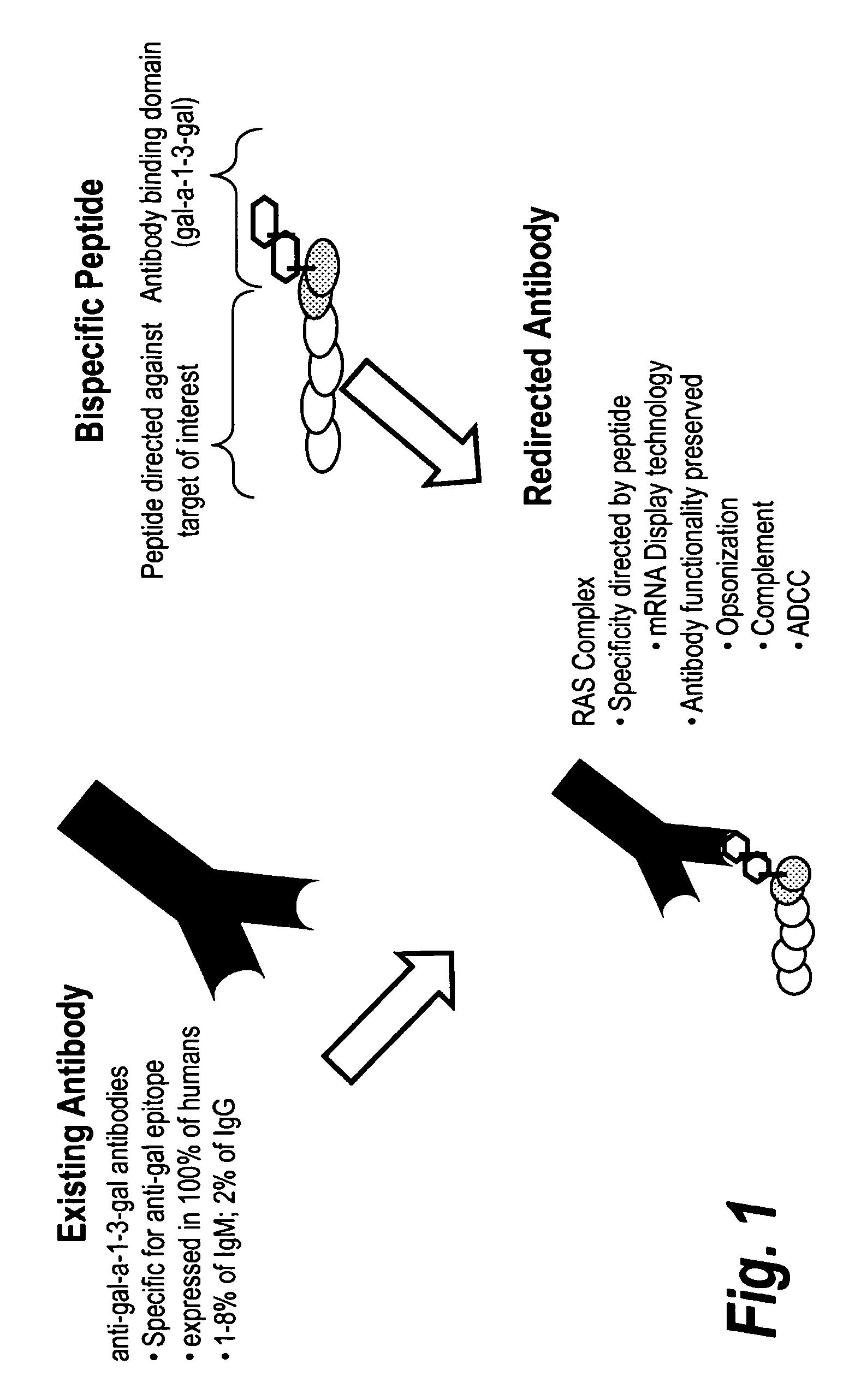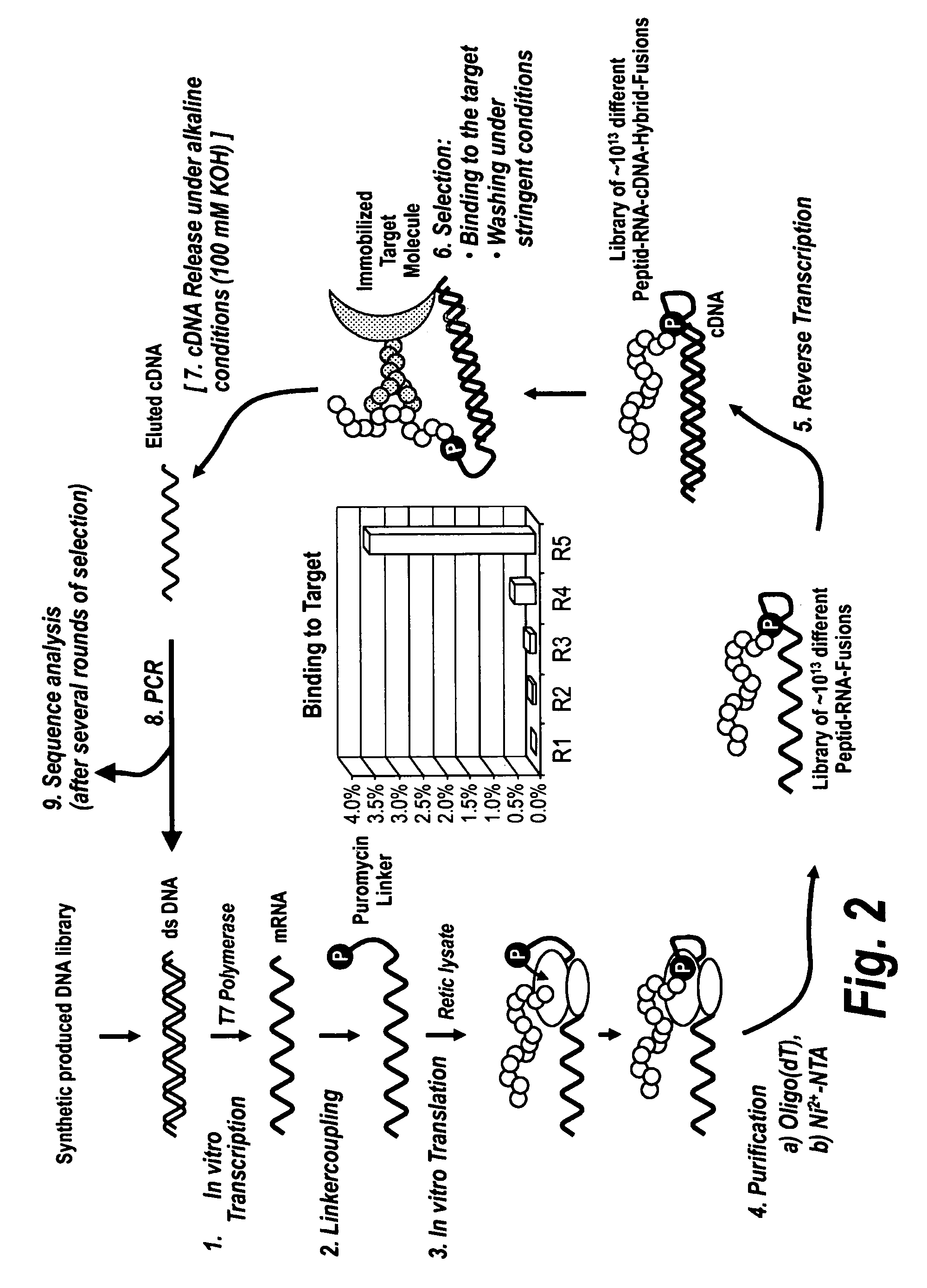High affinity adaptor molecules for redirecting antibody specifity
a technology of adaptor molecules and antibodies, applied in the field of isolated adaptor molecules, can solve the problems that most studies have not advanced beyond in vitro demonstrations, and achieve the effects of efficiently redirecting circulating antibodies, and high binding affinity and selectivity
- Summary
- Abstract
- Description
- Claims
- Application Information
AI Technical Summary
Benefits of technology
Problems solved by technology
Method used
Image
Examples
example 1
Selection of High Affinity Anti-VEGF Peptides as Targeting Moiety and Conjugation to an αGal Ligand Moiety
[0075]Using the mRNA display method depicted in FIG. 2, a library of randomized peptide sequence were screened for high affinity binding to VEGF. Four high affinity anti-VEGF peptide sequences (SEQ ID NOs 1-4) were selected. Each peptide was PEGylated at the C-terminus with PEG2-NH2 or PEG2-Cys-NH2 moiety (see FIG. 4) to facilitate chemical coupling to Gal antigen (Bdi-(CH2)-NH2, disacchride).
[0076]To facilitate chemical conjugation of each peptide to the Gal disaccharide, a bifunctional linker with maleimide and sulfo-NHS functionalities (Sulfo-SMCC, PIERCE) was employed. The linker was reacted with the amino group present in the disaccharide and a maleimide functionality in a sulfhydroxyl group of the C-terminal cysteine residues of the peptide. To obtain the desired compound and avoid any further reaction and formation of by-products, the reaction was subjected to RP-HPLC pur...
example 2
Anti-VEGF-specific Adaptor Molecules Can Redirect Natural Anti-αGal Antibodies to VEGF
[0077]An assay was designed to test the ability of αGal-linked anti-VEGF peptides to redirect natural antibodies, specific for αGal, to bind to VEGF. The assay was designed with recombinant VEGF on the solid phase. A dilution series of αGal-linked anti-VEGF peptides was then incubated with the rVEGF followed by an incubation with sera from mice containing high levels of anti-αGal. The amount of bound anti-αGal was then indicated by an enzyme conjugated anti-mouse antibody. The presence of enzyme was indicated by the addition of a colorometric substrate and the increase in color was measured by determining the optical density at 490 nm. The data, set forth in FIG. 8, clearly shows that the αGal-linked anti-VEGF peptides could redirect natural anti-αGal antibodies to VEGF since a decrease in the amount of peptide or antisera resulted in a decrease in the optical density.
PUM
| Property | Measurement | Unit |
|---|---|---|
| dissociation constant | aaaaa | aaaaa |
| dissociation constant | aaaaa | aaaaa |
| dissociation constant | aaaaa | aaaaa |
Abstract
Description
Claims
Application Information
 Login to View More
Login to View More - R&D
- Intellectual Property
- Life Sciences
- Materials
- Tech Scout
- Unparalleled Data Quality
- Higher Quality Content
- 60% Fewer Hallucinations
Browse by: Latest US Patents, China's latest patents, Technical Efficacy Thesaurus, Application Domain, Technology Topic, Popular Technical Reports.
© 2025 PatSnap. All rights reserved.Legal|Privacy policy|Modern Slavery Act Transparency Statement|Sitemap|About US| Contact US: help@patsnap.com



